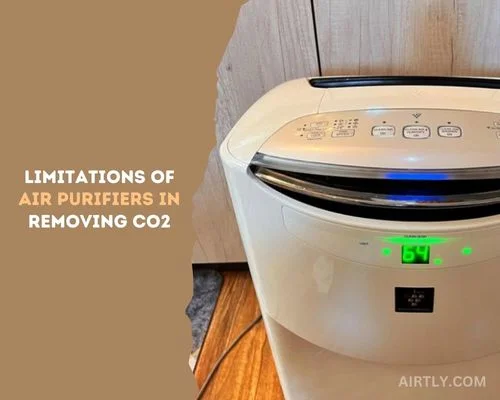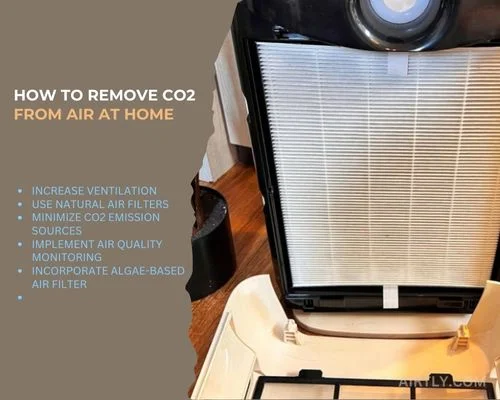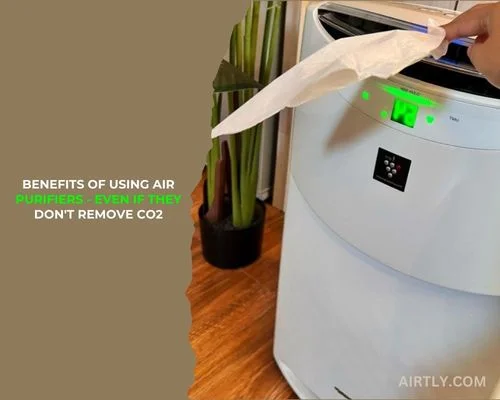Did you know when carbon dioxide levels rise in enclosed places, it causes headaches, fatigue, dizziness, and difficulty concentrating? You may have an air filter, but can it reduce CO2?
Unfortunately, no! Air purifiers are unable to reduce co2 from the air. They are able to remove fine particles, allergies, dust, and pollutants from the air, but they cannot lower carbon dioxide levels. Proper ventilation is essential for reducing carbon dioxide in enclosed environments.
Continue reading to discover the limitations of air purifiers, why reducing CO2 is important, how to reduce CO2 in indoor settings, and more.
Interested in similar topics on Air Purifiers:
What Are The Limitations of Air Purifiers in Removing CO2?
Air purifiers have a few limitations when it’s about to carbon dioxide (CO2) from the indoor atmosphere. Here are the main limitations:

Filter Design:
The majority of air purifiers use High-Efficiency Particulate (HEPA) Air filters. Dust and other air pollutants can be effectively removed by using this kind of filter. They aren’t made to capture CO2 molecules, though.
HEPA filters primarily target airborne particles such as dust, pollen, pet dander, and mold spores. They are not equipped with the necessary components to specifically target and remove CO2.
Limited to Provide Odor-Free Air:
An air purifier’s mainly used to get odor-free air. To serve this purpose, the manufacturer builds it with technology that focuses on improving indoor air quality by lowering particulate matter.
CO2 is an odorless gas, and it requires specialized filters or technology to filter out this gas from the air. The majority of ordinary air purifiers lack such gas-removal capabilities.
Why And When You Need to Reduce CO2 From Indoor Space?
It is essential to reduce CO2 levels in indoor settings. High levels of carbon dioxide negatively impact human health. When CO2 levels rise indoors, it can cause symptoms such as:

• Headaches
• Fatigue
• Difficulty concentrating
• Dizziness
• Shortness of breath
• Increased heart rate
So when the carbon dioxide increases over 700 ppm in indoor space, it becomes crucial to reduce it.
Moreover, reducing CO2 is essential for maintaining a comfortable and productive indoor environment. Excess amounts of this gas can contribute to a stuffy and stale atmosphere, making the space feel unpleasant and less inviting.
By lowering CO2 levels, you can promote a fresher and more rejuvenating environment, which can positively impact mood, focus, and overall comfort.
How to Remove CO2 from Air At Home?
Consider the following ways to successfully remove carbon dioxide (CO2) from the air at home:

Increase Ventilation:
If you ask, can ventilation alone effectively lower co2 levels? I would say yes. Proper ventilation is crucial for removing stale indoor air and replenishing it with fresh outdoor air.
Open windows and doors when weather conditions allow to allow for natural air circulation. You can also utilize mechanical ventilation systems, such as exhaust fans or air exchangers, to improve airflow and remove CO2.
Use Natural Air Filters:
Many people ask do plants remove carbon dioxide from the atmosphere. Of course, they do. Plants are natural air purifiers and can help reduce CO2 levels.
They absorb CO2 during photosynthesis and release oxygen, helping to improve indoor air quality. Consider incorporating indoor plants in your home to enhance air purification and add a touch of greenery.
Minimize CO2 Emission Sources:
Identify and minimize sources of CO2 within your home. Reduce your use of gas-powered equipment that emits carbon dioxide during burning, such as stoves and ovens.
Opt for electric alternatives when possible. The use of open flames, such as candles or fireplaces, also contributes to carbon dioxide production. You also need to minimize the use of these things or find an alternative.
Implement Air Quality Monitoring:
The CO2 levels in your house can be monitored with air quality monitors. These tools offer real-time data on interior air quality and can show you where more ventilation or other CO2 reduction measures are needed.
Incorporate Algae-Based Air Filter:
Recently algenair innovated a new technology of air filter that is called the atrium. This filter harness the natural ability of algae to absorb CO2 during photosynthesis.
Also, growing algae in your aquarium and setting up one for every room might help you to reduce carbon dioxide in your space.
Although these techniques can lower CO2 levels in your house, it is vital to remember that for overall indoor air quality, maintaining sufficient ventilation and establishing a healthy balance of indoor and outside air is essential.
Can Carbon Filters Remove CO2?
Usually, you might have a query. What is the purpose of an air purifier’s carbon filter? Isn’t it able to Remove CO2?
Carbon filters, such as activated carbon or charcoal filters, are ineffective at removing carbon dioxide straight from the air. These filters are mainly designed to catch and eliminate volatile organic compounds (VOCs), smells, and some gases through adsorption.
Carbon filters have a porous structure that allows them to trap and adsorb certain molecules and impurities from the air. They work by attracting and binding gas molecules to the surface of the carbon material.
Because of this, these filters’ ability to adsorb CO2 is constrained, and they are not made particularly to target carbon dioxide molecules.
Is There Any Other Kind Of Filter That Can Absorb CO2 From The Air?
Using zeolite filters, carbon dioxide can be removed from the internal atmosphere. Zeolite is a crystalline mineral with a unique structure that absorbs various gases, including CO2.
Because Zeolite filters are good at catching and removing CO2 molecules from the air, they are frequently employed in specialist air purification systems that target particular gas removal.
What Are The Other Benefits Of Using Air Purifiers, Even If They Don’t Remove CO2?
Even while air purifiers do not directly remove carbon dioxide, they give various benefits to indoor air quality. These advantages include:
• Removal of airborne particles, such as dust, pollen, pet dander, and mold spores, can improve respiratory health and alleviate allergies.
• Reduction of volatile organic compounds (VOCs) emitted by common household products, improving indoor air quality and reducing potential health risks.
• Elimination of unpleasant odors, such as cooking smells, tobacco smoke, and pet odors, results in a fresher and more pleasant indoor environment.

• Capture and neutralization of bacteria, viruses, and other harmful microorganisms, reducing the risk of airborne infections and promoting a healthier living space.
• Improvement of sleep quality by creating a cleaner and allergen-free sleeping environment.
• Alleviation of asthma and respiratory symptoms for individuals with respiratory conditions.
• Enhanced overall comfort and well-being through cleaner, fresher indoor air.
Air purifiers have limitations on removing carbon dioxide, but they still contain many benefits that help to breathe clean air. Their capacity to remove other contaminants and improve indoor air quality makes them useful in producing a healthier and more comfortable living environment.
Conclusion
Air purifiers, while highly effective at removing particles and pollutants from indoor air, have limitations in directly reducing CO2 levels. CO2 is a gas, and standard filters in air purifiers cannot trap it.
To effectively manage CO2, proper ventilation and specialized filters like zeolite filters will be required. Combining this method can create a healthier indoor environment, improving comfort and well-being.

